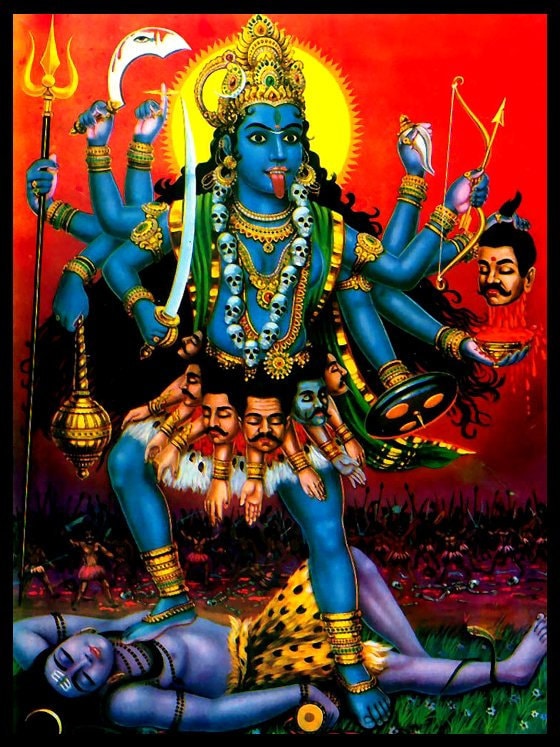One indication of yoga’s spiritual nature is the way it affects practitioners over time. Physical postures (asana) comprised about 60% of the yoga they practiced; 40% was relaxation (savasana), breathing techniques (pranayama), meditation, and instruction. most people begin yoga for reasons of physical health, however they usually continued it for reasons of spirituality. In addition, the more people practiced yoga, the more likely they were to decrease their adherence to Christianity and the more likely they were to adhere to non-religious spirituality and Buddhism.
Yoga is a physical expression of a spiritual exercise that is rooted in demon worship whose genesis is Hinduism.

Its aim is to control the body and the various forms of vital energy, with a view of overcoming physical impediments standing in the way of other, spiritual, forms of Yoga. Its object is to ensure a perfect balance between the organic functions. Its ultimate goal and true end is to prepare man for the acquisition of that repose of spirit necessary for the realization of the Christ consciousness or experience of the Divine aspect." Note: no where does JESUS CHRIST fit into this definition. The LIE is the same lie told in the garden by Lucifer that Man can be like GOD but only if he disobeys GOD, which is servile vanity. Such prideful egotism can only lead to blindness and ultimately one's own destruction.
The word “yoga” comes from the Sanskrit yuj, which indicates “to yoke together,” “union,” “to join, to bind.” Someone who practices Yoga as a way of life is called a yogin or a yogi. Because Yoga indicates binding, we must ask: what does Yoga bind us to? Classical Yoga tradition which is rooted in Hindu dictates that all Yoga should associate with the gods of India.
Hinduism is a nefarious collection of sects, demonic traditions, folk beliefs, and practices that evolved from the Vedas, some of the world’s oldest religious texts. This darkness congealed deep in the vast Indian subcontinent over the course of many centuries.

A Universal Hindu dogma which can be agreed upon by all Hindus is an impossibility Hinduism has no central authority, no founding figure, no historical starting point, no single creed or canonical doctrine, and more religious texts then any other religion on earth. Hinduism is really a collection of a thousand demonic voices screaming over another ten thousand lost souls screaming in HELL. Hinduism has been called “the world’s largest and most decentralized, disorganized religion. As with all things demonic Hindus have six principle schools that represent authentic developments of the Vedic scriptures, none of which agree with the other. Yoga is just one of the many devil traps of the Verdic scriptures. A physical practice which spiritually ensnares the participants souls. What starts out as exercise for westerners soon becomes the worship of demonic spirits.

Shiva has prominence among the gods of Yoga. He is the “patron” of all Yoga practitioners: “He is the deity of yogins and is often depicted as a yogin.” Around his neck is a serpent, symbolizing his power over death; on his forehead is a third eye, through which he gains mystical vision and knowledge. His drumbeat is said to create the OM which reverberates in the heart and throughout the universe. In some depictions Shiva assumes the lotus posture in deep meditation. In other cases Shiva juggles fire while he dances with one foot in the air, indicating release from “earthly bondage.”

Many traditions include Shiva in a Hindu triad or trinity of gods, with Brahman as the “creator”, Vishnu as the “sustainer” or “preserver.” Shiva is said to be “the destroyer,” the one who annihilates the illusions of the ego and therefore gains liberation into ultimate reality:
Vishnu is another important god for Yoga; he is said to preserve and maintain the cosmic order dharma. Like Shiva, he is depicted with blue skin and four arms and is accompanied by serpents. It is said that Vishnu was incarnate nine times, the last two being the most significant: as Krishna and Buddha. Here I will focus on Krishna.
The Bhagavad-Gita, part of an ancient Hindu religious epic, portrays Krishna as the perfect Yoga guru to his disciple, the human hero Arjuna. Chapter 6 of the Gita contains material that would be familiar to many modern Yoga practitioners. Krishna defines Yoga negatively as “renunciation” of illusion and positively as “yoking oneself to the Supreme Consciousness” (6:2). For him, a yogin is one “established in self-realization” (6:8). Through elevating himself through his own mind (6:5), a Yoga practitioner attains the abode of Krishna, perfect happiness, “by cessation of material existence” (6:15). The means to acquire this is by practicing control of the body, mind, and activity with specific postures and meditation techniques (6:11-18).

The Yoga goddesses should not be neglected in our account. Here we can turn to the chief goddess, Shakti or Durga, known under different aspects. Shakti is seen as the divine force that destroys evil and restores balance: she “represents the cosmic energy of destruction of the ego, which stands in the way of spiritual growth and ultimate liberation.” In some instances, Shakti assumes the role of Parvati, the energy and consort of Shiva; in other instances, the role of Lakshmi, the energy and consort of Vishnu. The most fearsome role Shakti plays is as Kali, the “Dark Mother” goddess, who, standing naked, wears a garland of skulls around her neck and a belt of heads around her waist, wielding a bloody sword and clutching a severed head. It is not uncommon for Yoga teachers to recommend tapping into this feminine-divine source of empowerment
No comments:
Post a Comment